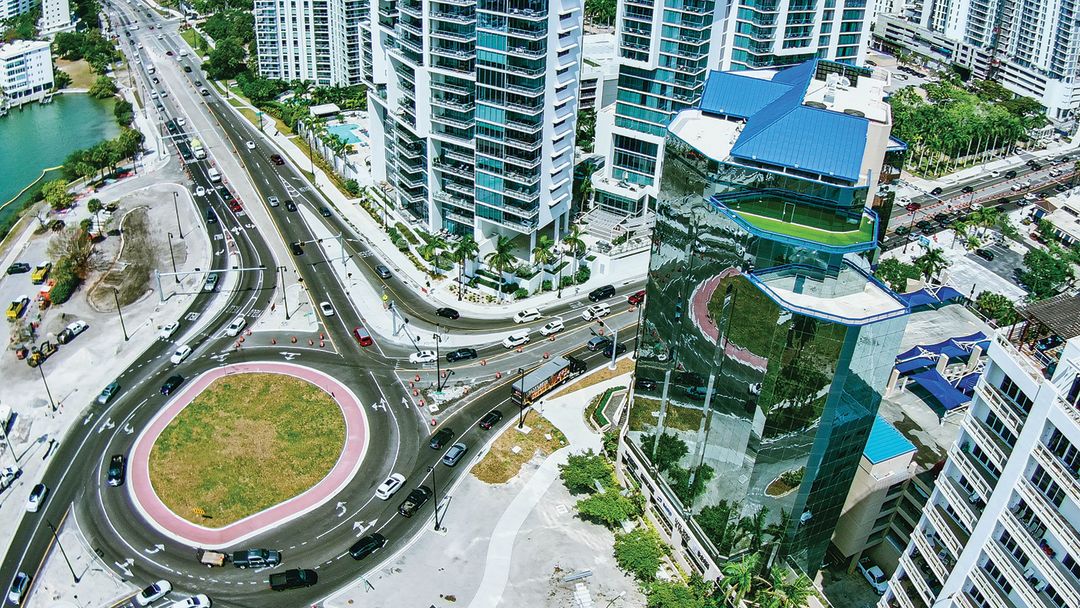Traffic Circles Can Actually Be Straightforward, Driving Instructors Say

Image: Hannah Phillips
With traffic already circulating through 21 roundabouts in Sarasota and Manatee counties, and with 17 more planned by 2030, driving instructors are noticing their students still dread the ways of the circle.
The trepidation surrounding roundabouts is particularly high for young or inexperienced drivers, which can contribute to more crashes, instructors say.
“Most new drivers struggle with roundabouts because we have to almost disconnect the hands from the eyes when we’re driving,” says Michael Rowell, a driving instructor, lifelong resident of Sarasota and vice president of Suncoast Defensive Driving School. “We want to look in the direction that we’re turning. With roundabouts, we’re steering right to enter the roundabout, but the current yield is coming from your left, making it difficult for most drivers.”
So it should come as no surprise that one of the region’s most crash-prone junctions was a roundabout located at Jacaranda Avenue and East Venice Avenue, according to a summary of county crash reports that ended in 2020, according to data from the Sarasota-Manatee Metropolitan Planning Organization. Here's a look at how other roundabouts fared.
- In a two-year span before a roundabout was built in 2019 at Martin Luther King Avenue East and 15th Street East north of downtown Sarasota, 16 crashes were reported there. Two years after, that number was two.
- At Honore Avenue and Central Sarasota Parkway in Sarasota, 18 crashes were reported in the three years before the roundabout was built in 2018, and 19 in the three years after.
- At Cocoanut Avenue and Palm Avenue in downtown Sarasota, 10 crashes were reported in the four years before the roundabout was built in 2017, and two in the four years after.
- At Main Street and Orange Avenue in downtown Sarasota, where a roundabout was built in 2015, three crashes were reported in 2011-2015 and 22 in 2015-2020.
- At Jacaranda Avenue and Venice Boulevard in Venice, where the roundabout was built in 2011 and improved in 2016, a total of 268 crashes have taken place through 2021. Seven non-incapacitating injuries were reported.
- Injuries at all the roundabouts noted by the MPO fell or remained constant (one before and one after at Bee Ridge Road and Lorraine Road).

Drivers make their way around the intersection of Tamiami Trail and 10th Street in Sarasota.
The key to understanding how to navigate roundabouts is finding an effective technique to merge into traffic and keep your target exit in mind, according to both Rowell and Mark Paxton, a driving instructor at Driving School of Florida who teaches in Sarasota, Manatee, Pinellas and Hillsborough counties.
Paxton uses a clock analogy to teach his students how roundabouts work and finds his students take to the method of yielding to oncoming drivers better than other tactics.
“When we are coming into a roundabout, if you think of the circle in the middle of the roundabout like a clock on the wall, you usually have four entrances and exits to the roundabout,” Paxton said.
He uses this analogy to explain to students which lane to choose when entering based on what “time” they plan on exiting the roundabout, as well as timing their "go, no-go" decision to enter the roundabout.
At the Driving School of Florida, one Sarasota student driver crashed during a lesson at a roundabout when another driver failed to yield.
“It wasn’t even our student’s fault,” Paxton said. “Even the more experienced drivers tend to not understand it—or maybe people are just in a hurry and impatient and want to cut in front of people, even if they don’t have the right of way.”
Still, according to the Florida Department of Transportation, roundabouts are more efficient, as they require minimal maintenance compared to traffic lights and are safer, reducing injuries in accidents by approximately 70 percent.
“Where we live, it’s a perfect storm of types of drivers,” Rowell says. “We have snowbirds, young kids, older drivers, tourists and all sorts of people who have never really encountered roundabouts regularly before.”
A key component of safely navigating roundabouts is education, according to Rowell and Paxton—encouraging drivers who feel hesitant towards roundabouts to seek education on how to safely navigate them.
“The younger generation is witnessing how the parents are driving. If the parents are confused about it, that typically is passed down [to the kids], as well,” Rowell says. “If you understand who you're supposed to yield to and when you're supposed to yield to them, we can actually start to decrease the frequency of the accidents in these roundabouts.”
Catherine Hicks is a reporter for the Community News Collaborative. She can be reached at [email protected].



